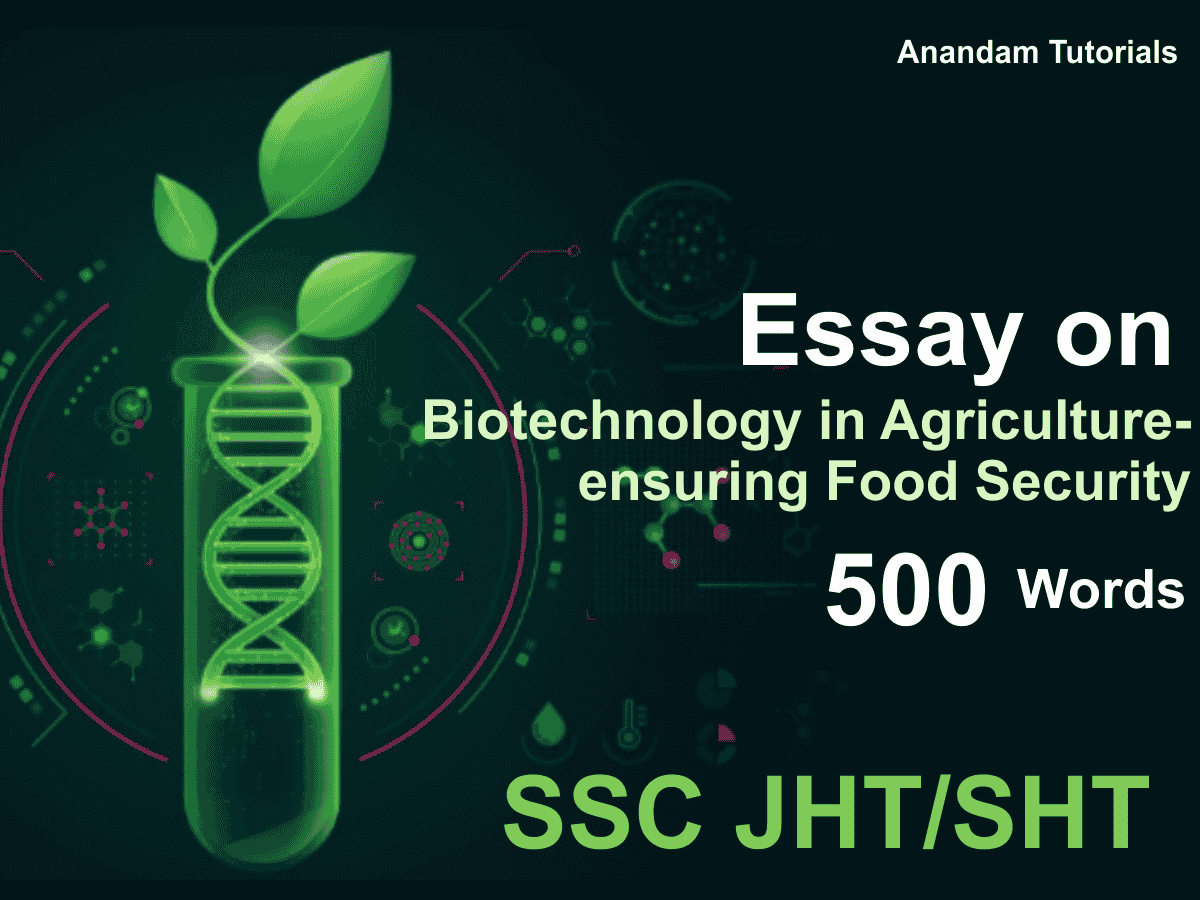The SSC
Junior Hindi Translator (JHT) exam has two papers:
- Paper-I (Objective Type) –
100 questions each from General Hindi and General English
(total 200 marks).
- Paper-II (Descriptive Type)
– Translation and Essay Writing (total 200 marks).
Two essays carrying 50 marks each are asked in Hindi and in English in the SSC CHT Exam out of 200 marks
The topics are generally related to language, literature, governance, social issues, or current national concerns (e.g., Digital Governance, Women Empowerment, etc.).
It tests
your
- Language
Mastery –
The essay
examines your ability to write in a clear, formal, and structured manner with
correct grammar, idiomatic expressions, and appropriate vocabulary.
- Reflection
of Thought Process –
Examiners
judge whether you can express ideas logically, coherently, and
persuasively—skills crucial for a translator’s role.
The following is an essay. Read it properly and notice the format: -
Biotechnology
in Agriculture: Ensuring Food Security
“The
world has the technology — and the scientific capacity — to end hunger.”
—
Norman Borlaug (Father of Green Revolution)
Biotechnology today stands at the crossroads of that promise and India’s
urgent need to secure food for a growing population. When deployed responsibly,
biotech tools — from proven transgenic crops to modern gene-editing and
microbial bioinputs — can raise yields, cut losses, reduce chemical use and
improve nutritional quality, all of which strengthen food security. In India,
the impact is already visible in cotton, while other technologies
(hybridization, biofertilizers, molecular breeding and gene-editing research)
are being scaled through public-private partnerships, government R&D
funding and a fast-growing agri-biotech startup ecosystem. At the same time,
regulatory, biosafety and socio-economic debates (notably around GM mustard)
show India’s path will require careful science, transparent regulation and
farmer-centric policies to ensure benefits reach smallholders and consumers
alike.
India’s tryst with agricultural biotechnology began in earnest with the
commercial approval of Bt cotton in 2002. Since then, it has transformed cotton
cultivation, covering more than 12 million hectares and accounting for nearly
90–95% of India’s cotton area. Farmers have reported reduced pesticide use,
higher yields, and better incomes, demonstrating how biotech interventions can
directly impact productivity and livelihoods. However, this success has
remained largely confined to cotton, while food crops such as brinjal and
mustard have faced regulatory hurdles and public opposition.
The need for diversification is urgent. India’s population is expected
to reach 1.7 billion by 2050, requiring food grain output to almost double.
Climate change compounds the challenge: erratic monsoons, prolonged droughts,
and new pest infestations put immense stress on traditional farming practices.
Biotechnological innovations like drought-tolerant rice, pest-resistant pulses,
and fortified cereals can provide viable solutions. Moreover, gene-editing
tools such as CRISPR offer the potential to enhance crops without introducing
foreign genes, which may reduce ethical and biosafety concerns.
Beyond transgenics, India is witnessing growth in biofertilizers,
biopesticides, and microbial solutions that reduce dependency on chemical
inputs. This not only improves soil health but also aligns with sustainable
development goals. The government, through the Department of Biotechnology and
agencies like BIRAC, has been investing in public-private partnerships,
agri-incubators, and startup funding to scale innovations. Reports on the
Indian bioeconomy highlight that agriculture is emerging as a key driver of
this growth.
Yet, challenges remain significant. Public skepticism, legal disputes
such as those surrounding GM mustard, and fragmented regulatory processes have
slowed down adoption. Concerns about biodiversity, seed monopolies, and
farmers’ autonomy need to be addressed through transparent regulation, strong
biosafety assessment, and farmer-centric policies. Equally important is the
role of awareness campaigns to bridge the information gap between scientific
evidence and public perception.
Thus, biotechnology in Indian agriculture is at a crossroads: it has the
potential to ensure food and nutritional security, but only if pursued
responsibly, inclusively, and sustainably.
If India can couple rigorous science with responsible governance, and ensure that smallholders—who form the backbone of Indian agriculture—gain equitable access to biotech innovations, then biotechnology can become a cornerstone of the nation’s food security strategy. In this way, science will not only feed the people but also uphold sustainability, resilience, and dignity in Indian agriculture.
For more, follow link - SSC JHT Translator Exam Paper-II
